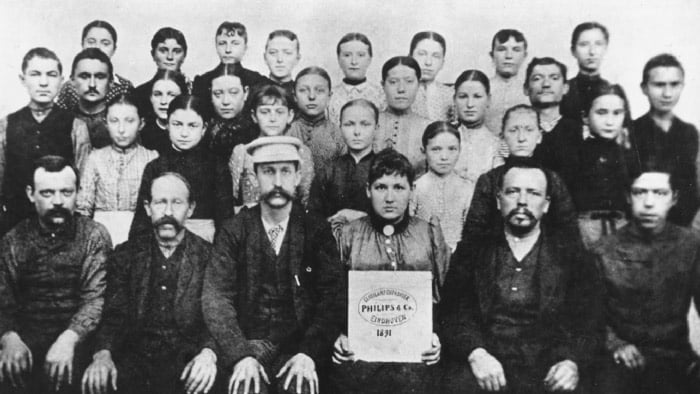Philips was founded in 1891 by Gerard Philips and his father, Frederik, in Eindhoven, Netherlands. The company’s journey began with the production of a carbon-filament lamp, and from these early days, they set the stage for future breakthroughs. Despite facing early financial struggles and intense competition, Philips' dedication to quality and continuous innovation led them toward global success. What started as a small factory grew into a major force that would go on to transform multiple industries. Uncover the advanced capabilities of the Philips 5500 LatteGo review
Early Expansion and Revolutionary Innovation
By the early 1900s, Philips had quickly become one of Europe's leading light bulb manufacturers. Their rapid expansion was driven by both mass production and a strong commitment to innovation. A key turning point came in 1914 when the company established its Research Laboratory, known as NatLab. NatLab became a hub for scientific discovery, laying the foundation for the company's future technological advancements. Get a closer look at the features of the Philips 5400 LatteGo review
The Rise of Radio Technology
In the 1920s and 1930s, Philips recognized the growing influence of radio technology. In 1927, the company began producing radios that became known for their affordability and superior quality. By 1932, Philips had sold over a million radios, securing its position as a leader in the consumer electronics market and staying ahead of technological trends. Compare these two machines side by side in the Philips LatteGo 5400 vs 4300 review
Overcoming Challenges During World War II
World War II presented major challenges for Philips, with operational disruptions and damage to facilities. Despite these setbacks, the company’s resilience remained evident. Key personnel were relocated to safer locations, and research continued throughout the war. Philips also contributed to advances in radar technology and other fields, demonstrating its capacity to innovate under difficult circumstances. Discover the differences among these models in the Philips 3200 vs 4300 vs 5400 review
Post-War Innovation and the Compact Cassette
After World War II, Philips entered a phase of rapid growth and technological development. One of its most significant innovations came in 1963 with the creation of the compact audio cassette. This invention revolutionized the music industry by providing a portable, affordable medium for music recording and playback. The cassette tape dominated for decades, profoundly changing consumer behavior and the music industry landscape. Learn how these two models compare in the Philips 3200 vs 4300 review

Transforming Music: The Compact Disc
In the late 1970s, Philips teamed up with Sony to create the compact disc (CD), a durable and digital format that soon replaced the cassette as the standard for music playback. The CD became a global sensation, solidifying Philips' reputation as a leader in the music industry and pushing forward digital technology. See what sets these models apart in the Philips 3200 vs 5400 review
Expanding into Consumer Electronics and TV
As the 20th century progressed, Philips diversified its product lines, making significant strides in consumer electronics. The company played a crucial role in the development of home entertainment technologies, including the VHS tape and the DVD, which revolutionized the way people watched movies. In the 1990s, Philips introduced the Ambilight TV, a groundbreaking technology that enhanced viewing experiences by projecting ambient light around the screen. Get a detailed review of the Philips LatteGo 5400 review
Shifting Focus Toward Healthcare Technology
In the 1980s, Philips identified the growing need for healthcare solutions and began investing heavily in medical technologies. This shift included expanding into medical imaging, patient monitoring, and health informatics. Philips positioned itself as a leader in the healthcare sector through strategic acquisitions and a strong focus on innovation, aiming to improve patient care and drive advancements in medical research. Discover the compact and efficient design of the Philips 3200 LatteGo review
A New Era: Transitioning to Health Tech
In recent years, Philips has undergone a major transformation, moving away from traditional consumer electronics to focus primarily on health technology and lighting solutions. In 2016, the company spun off its lighting division into Signify, allowing Philips to focus entirely on innovations in health technology. Today, Philips leads the way in connected care, digital health solutions, and advanced medical devices, aligning its mission with global priorities in health and wellness. Dive into the advanced features of the Philips 4300 LatteGo review
Commitment to Sustainability and Corporate Responsibility
Philips has always been committed to sustainability and corporate responsibility. The company has set ambitious sustainability goals, including achieving carbon-neutral operations and embracing circular economy practices. Philips’ sustainability efforts are closely tied to its mission to improve global health, creating products that positively impact both society and the environment.
Digital Health and AI Integration
As the world moves toward digital solutions, Philips has embraced artificial intelligence (AI) and data analytics to enhance healthcare delivery. By integrating AI into connected care solutions, the company is improving healthcare efficiency and patient outcomes. With a focus on personalized health, AI-driven diagnostics, and connected devices, Philips is shaping the future of healthcare to ensure technology enhances patient care and well-being.

Conclusion: A Legacy of Innovation and Impact
Philips’ journey from a small light bulb manufacturer in Eindhoven to a global leader in health technology is a testament to the company’s resilience, adaptability, and constant drive for innovation. Philips’ legacy spans industries, from transforming home entertainment to revolutionizing healthcare. As the company continues to push boundaries and innovate, its story remains a powerful example of how perseverance, creativity, and a commitment to improving lives can lead to lasting success. With a continued focus on health technology, Philips is poised for a future as dynamic and impactful as its remarkable past.
Frequently Asked Questions (FAQ)
Q: When was Philips founded?
A: Philips was founded in 1891 by Gerard Philips and his father, Frederik Philips, in Eindhoven, Netherlands.
Q: What was Philips' first product?
A: The first product manufactured by Philips was the carbon-filament lamp.
Q: What is NatLab, and why is it important?
A: NatLab, the Philips Research Laboratory, was established in 1914 and played a crucial role in driving future technological breakthroughs.
Q: How did Philips impact the music industry?
A: Philips revolutionized the music industry by introducing the compact audio cassette in 1963 and collaborating with Sony to launch the compact disc (CD) in the late 1970s.
Q: How has Philips evolved in recent years?
A: In recent years, Philips shifted its focus from traditional consumer electronics to health technology, spinning off its lighting division as Signify and concentrating on health innovations.
Q: How is Philips contributing to healthcare today?
A: Philips is leading in connected care, medical imaging, patient monitoring, and health informatics, using advanced technology to improve healthcare outcomes.
Q: What sustainability efforts has Philips undertaken?
A: Philips has set goals to achieve carbon-neutral operations, adopt circular economy practices, and create products that positively impact both society and the environment.
